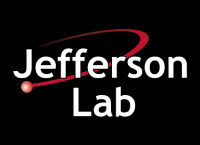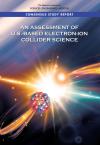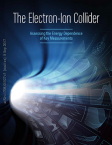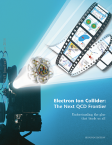JEFFERSON LAB SEARCH
-
Thomas Jefferson National Accelerator Facility (Jefferson Lab) provides scientists worldwide the lab’s unique particle accelerator, known as the Continuous Electron Beam Accelerator Facility (CEBAF), to probe the most basic building blocks of matter by conducting research at the frontiers of nuclear physics (NP) and related disciplines. In addition, the lab capitalizes on its unique technologies and expertise to perform advanced computing and applied research with industry and university partners, and provides programs designed to help educate the next generation in science and technology.
Majority of computational science activities in Jefferson Lab focus on these areas : large scale and numerical intensive Lattice Quantum Chromodynamics (LQCD) calculations, modeling and simulation of accelerators and the experiment detectors, fast data acquisition and streaming data readout, high throughput computing for data analysis of experimental data, and large scale distributed data storage and management.
Many Jefferson Lab scientists and staffs lead or actively participate the computational efforts in the above areas. Among those are computer/computational scientists and computer professionals from newly formed computational sciences and technology division (CST), physicists from physics division and the Center for Theoretical and Computational Physics, and accelerator physicists from Center for Advanced Studies of Accelerators (CASA). In addition, collaborations with universities and industrial partners further research and development in computational science.
Jefferson Lab maintains various state of art high performance computing resources onsite. CSGF students will utilize these resources to carried out their researches in the specific areas described below:
Accelerator Modeling
CASA and Jefferson Lab SRF institute focus on advanced algorithms, such as fast multipole methods, for multiparticle accelerator dynamics simulations, artificial intelligence (AI) and machine learning (ML) applied to superconducting RF (SRF) accelerator operations, and integrated large and multi-scale modeling of SRF accelerator structures. These areas will be an essential part of a national strategy to optimize DOE operational facility investments, and to strengthen Jefferson Lab’s core competency of world-leading SRF advanced design and facility operations. Especially, current active simulation projects
like electron cooling, intra-beam scattering, and coherent synchrotron radiation present diverse research domains ranging from numerical algorithms development to parallel computing.
Streaming Data Readout
With tremendous advancement in micro-electronics and computing technologies in the last decade, many nuclear physics and high-energy physics experiments are taking advantage of these developments by upgrading their existing triggered data acquisition to a streaming readout model (SRO) , whereby detectors are continuously read out in parallel streams of data. An SRO system, which could handle up to 100 Gb/s data throughput, provides a pipelined data analysis model to nuclear physics experiments where data are analyzed and processed in near real-time fashion. Jefferson Lab is leading a collaborative research and development effort to devise SRO systems not only for CEBAF 12GeV experiments but also for the upcoming EIC facility. SRO development offers CSGF students some exciting research areas such as network protocol design, high speed data communication, high performance data compression and distributed computing.
Physics Data Analysis
Analysis of data from modern particle physics experiments uses technically advanced programming and computing techniques to handle the large volumes of data. One not only needs to understand aspects of parallel programming using modern languages such as C/C++, Java, and Python, but also must incorporate knowledge of experimental techniques involving error propagation and estimation in order to properly interpret the results. Aspects of this range from writing a single algorithm used in event reconstruction, to using the collection of algorithms written by others, to managing campaigns at HPC facilities that apply these algorithms to large datasets. Detector calibrations and final physics analysis are also significant parts of the analysis chain. CSGF students could participate in any of these areas.
Machine Learning
Rapid developments in hardware computational power and an ever increasing set of data has lead to explosive growth in machine learning techniques, specifically deep learning techniques. These techniques threaten to change just about every facet of modern life and nuclear physics is no exception. At Jefferson Lab machine learning is being developed for every step in the physics workflow. To deliver beam to the experimental halls the accelerator relies on radio frequency (RF) cavities to accelerate the electrons. Occasionally these cavities, of which there are over 400 in operation around the accelerator, fault which disrupts the delivery of the beam to experiments. To quickly identify and diagnose cavity faults A.I. is being developed and deployed. Experiments themselves are developing and/or deploying A.I. to monitor detector performance, decide what data to keep, reconstruct detector responses, simulate the detectors, and even to analyze collected data. With the active development of machine learning tools and techniques Jefferson Lab hopes to drive nuclear physics research forward, enabling physicists to more quickly obtain and analyze high quality data.
-
- Start typing the title of a piece of content to select it.
- Contrary to popular belief, Lorem Ipsum is not simply random text. It has roots in a piece of classical Latin literature from 45 BC, making it over 2000 years old. Richard McClintock, a Latin professor at Hampden-Sydney College in Virginia, looked up one of the more obscure Latin words, consectetur, from a Lorem Ipsum passage, and going through the cites of the word in classical literature, discovered the undoubtable source. Lorem Ipsum comes from sections 1.10.32 and 1.10.33 of "de Finibus Bonorum et Malorum" (The Extremes of Good and Evil) by Cicero, written in 45 BC. This book is a treatise on the theory of ethics, very popular during the Renaissance. The first line of Lorem Ipsum, "Lorem ipsum dolor sit amet..", comes from a line in section 1.10.32.
Contrary to popular belief, Lorem Ipsum is not simply random text. It has roots in a piece of classical Latin literature from 45 BC, making it over 2000 years old. Richard McClintock, a Latin professor at Hampden-Sydney College in Virginia, looked up one of the more obscure Latin words, consectetur, from a Lorem Ipsum passage, and going through the cites of the word in classical literature, discovered the undoubtable source. Lorem Ipsum comes from sections 1.10.32 and 1.10.33 of "de Finibus Bonorum et Malorum" (The Extremes of Good and Evil) by Cicero, written in 45 BC. This book is a treatise on the theory of ethics, very popular during the Renaissance. The first line of Lorem Ipsum, "Lorem ipsum dolor sit amet..", comes from a line in section 1.10.32.
Contrary to popular belief, Lorem Ipsum is not simply random text. It has roots in a piece of classical Latin literature from 45 BC, making it over 2000 years old. Richard McClintock, a Latin professor at Hampden-Sydney College in Virginia, looked up one of the more obscure Latin words, consectetur, from a Lorem Ipsum passage, and going through the cites of the word in classical literature, discovered the undoubtable source. Lorem Ipsum comes from sections 1.10.32 and 1.10.33 of "de Finibus Bonorum et Malorum" (The Extremes of Good and Evil) by Cicero, written in 45 BC. This book is a treatise on the theory of ethics, very popular during the Renaissance. The first line of Lorem Ipsum, "Lorem ipsum dolor sit amet..", comes from a line in section 1.10.32. - You can also enter an internal path such as /node/add or an external URL
- Start typing the title of a piece of content to select it.
- Contrary to popular belief, Lorem Ipsum is not simply random text. It has roots in a piece of classical Latin literature from 45 BC, making it over 2000 years old. Richard McClintock, a Latin professor at Hampden-Sydney College in Virginia, looked up one of the more obscure Latin words, consectetur, from a Lorem Ipsum passage, and going through the cites of the word in classical literature, discovered the undoubtable source. Lorem Ipsum comes from sections 1.10.32 and 1.10.33 of "de Finibus Bonorum et Malorum" (The Extremes of Good and Evil) by Cicero, written in 45 BC. This book is a treatise on the theory of ethics, very popular during the Renaissance. The first line of Lorem Ipsum, "Lorem ipsum dolor sit amet..", comes from a line in section 1.10.32.
Contrary to popular belief, Lorem Ipsum is not simply random text. It has roots in a piece of classical Latin literature from 45 BC, making it over 2000 years old. Richard McClintock, a Latin professor at Hampden-Sydney College in Virginia, looked up one of the more obscure Latin words, consectetur, from a Lorem Ipsum passage, and going through the cites of the word in classical literature, discovered the undoubtable source. Lorem Ipsum comes from sections 1.10.32 and 1.10.33 of "de Finibus Bonorum et Malorum" (The Extremes of Good and Evil) by Cicero, written in 45 BC. This book is a treatise on the theory of ethics, very popular during the Renaissance. The first line of Lorem Ipsum, "Lorem ipsum dolor sit amet..", comes from a line in section 1.10.32.
Contrary to popular belief, Lorem Ipsum is not simply random text. It has roots in a piece of classical Latin literature from 45 BC, making it over 2000 years old. Richard McClintock, a Latin professor at Hampden-Sydney College in Virginia, looked up one of the more obscure Latin words, consectetur, from a Lorem Ipsum passage, and going through the cites of the word in classical literature, discovered the undoubtable source. Lorem Ipsum comes from sections 1.10.32 and 1.10.33 of "de Finibus Bonorum et Malorum" (The Extremes of Good and Evil) by Cicero, written in 45 BC. This book is a treatise on the theory of ethics, very popular during the Renaissance. The first line of Lorem Ipsum, "Lorem ipsum dolor sit amet..", comes from a line in section 1.10.32. - You can also enter an internal path such as /node/add or an external URL
- Start typing the title of a piece of content to select it.
- You can also enter an internal path such as /node/add or an external URL
- Start typing the title of a piece of content to select it.
- You can also enter an internal path such as /node/add or an external URL
-
Computational Sciences and Technology (CST) Division
News
Status
More information about the status of an electron-ion collider can be found in the documents linked below. In 2018, the National Academies of Sciences, Engineering and Medicine issued a report, “An Assessment of U.S.-Based Electron-Ion Collider Science.” Following the report, the directors of Thomas Jefferson National Accelerator Facility and Brookhaven National Laboratory issued a joint statement of support. More information about the impetus for building an electron-ion collider can be found in the 2015 Long-Range Plan, issued by the Nuclear Science Advisory Committee..
Benefits

Beyond sparking scientific discoveries in a new frontier of fundamental physics, an Electron-Ion Collider will trigger technological breakthroughs that have broad-ranging impacts on human health and national challenges. Research on the technologies needed to make this machine a reality is already pushing the evolution of magnets and other particle accelerator components.
Some of these advances could lead to energy-efficient accelerators, thereby dramatically shrinking the size and operating costs of accelerators used across science and industry for example, to make and test computer chips; to deliver energetic particle beams to zap cancer cells; to study and design improved sustainable energy technologies such as solar cells, batteries, and catalysts; and to develop new kinds of drugs and other medical treatments. New methods of particle detection developed for an EIC could also lead to advances in medical imaging and national security.
In truth, it’s nearly impossible to predict what will come from the knowledge gained from an EIC. History shows that applications springing from a deeper understanding of matter and fundamental forces things like GPS, microelectronics, and radiological techniques for diagnosing and treating disease often emerge many years after the foundational physics discoveries that make them possible.
But one thing is certain: Building the experiments that inspire and train the next generation of scientific explorers is essential for maintaining U.S. leadership in nuclear science and for developing the high-tech workforce needed to address some of our nation’s deepest challenges.Design

The Electron-Ion Collider would consist of two intersecting accelerators, one producing an intense beam of electrons, the other a beam of either protons or heavier atomic nuclei, which are then steered into head-on collisions.
The accelerators will be designed so that both beams can be polarized to around 70 percent for electrons, protons and light nuclei. Electrons will be able to probe particles from protons to the heaviest stable nuclei at a very wide range of energies, starting from 20–100 billion electron-volts (GeV), upgradable to approximately 140 GeV, to produce images of the particles’ interiors at higher and higher resolution. At least one detector and possibly more would analyze thousands of particle collisions per second, amassing the data required to tease out the smallest effects required for significant discoveries.
Building the EIC will require the same core expertise that led to the versatility of the polarized proton and heavy ion beams at the Relativistic Heavy Ion Collider (RHIC) at Brookhaven National Laboratory, and the unique polarized electron beam properties of the Continuous Electron Beam Accelerator Facility (CEBAF) at Thomas Jefferson National Accelerator Facility. These two Department of Energy laboratories have been collaborating on initial studies and developing designs that make use of key existing infrastructure and capitalize on investments in science and technology. Each design approach would require the development of innovative accelerator and detector technologies to answer the questions described in this brochure.
Goals
There are many scientific questions that researchers expect an Electron-Ion Collider will allow them to answer. Among them are four main topics of study.
 3D Structure of Protons and NucleiScientists would use the Electron-Ion Collider to take three-dimensional precision snapshots of the internal structure of protons and atomic nuclei. As they pierce through the larger particles, the high-energy electrons will interact with the internal microcosm to reveal unprecedented details—zooming in beyond the simplistic structure of three valence quarks bound by a mysterious force. Recent experiments indicate that gluons—the glue-like carriers of the strong nuclear force that binds quarks together—multiply and appear to linger within particles accelerated close to the speed of light, and play a significant role in establishing key properties of protons and nuclear matter. By taking images at a range of energies, an EIC will reveal features of this “ocean” of gluons and the “sea” of quark-antiquark pairs that form when gluons split—allowing scientists to map out the particles’ distribution and movement within protons and nuclei, similar to the way medical imaging technologies construct 3D dynamic images of the brain. These studies may help reveal how the energy of the massless gluons is transformed through Einstein’s famous equation, E=mc2, to generate most of the mass of visible matter.
3D Structure of Protons and NucleiScientists would use the Electron-Ion Collider to take three-dimensional precision snapshots of the internal structure of protons and atomic nuclei. As they pierce through the larger particles, the high-energy electrons will interact with the internal microcosm to reveal unprecedented details—zooming in beyond the simplistic structure of three valence quarks bound by a mysterious force. Recent experiments indicate that gluons—the glue-like carriers of the strong nuclear force that binds quarks together—multiply and appear to linger within particles accelerated close to the speed of light, and play a significant role in establishing key properties of protons and nuclear matter. By taking images at a range of energies, an EIC will reveal features of this “ocean” of gluons and the “sea” of quark-antiquark pairs that form when gluons split—allowing scientists to map out the particles’ distribution and movement within protons and nuclei, similar to the way medical imaging technologies construct 3D dynamic images of the brain. These studies may help reveal how the energy of the massless gluons is transformed through Einstein’s famous equation, E=mc2, to generate most of the mass of visible matter. Solving the Mystery of Proton SpinThe Electron-Ion Collider would be the world’s first polarized electron-proton collider where both the electron and proton beams have their spins aligned in a controllable way. This polarization makes it possible to make precision measurements of how a proton’s constituent quarks and gluons and their interactions contribute to the proton’s intrinsic angular momentum, or spin. Spin influences the proton’s optical, electrical, and magnetic characteristics and makes technologies such as MRI scanning work, but its origin has eluded physicists ever since experiments in the 1980s revealed that quarks can account for only about a third of the total spin. More recent experiments show that gluons make a significant contribution, perhaps even more than the quarks. An Electron-Ion Collider would produce definitive measurements of the gluons’ contributions, including how their movements within the proton microcosm affect its overall spin structure—thus providing the final pieces needed to solve this longstanding puzzle.
Solving the Mystery of Proton SpinThe Electron-Ion Collider would be the world’s first polarized electron-proton collider where both the electron and proton beams have their spins aligned in a controllable way. This polarization makes it possible to make precision measurements of how a proton’s constituent quarks and gluons and their interactions contribute to the proton’s intrinsic angular momentum, or spin. Spin influences the proton’s optical, electrical, and magnetic characteristics and makes technologies such as MRI scanning work, but its origin has eluded physicists ever since experiments in the 1980s revealed that quarks can account for only about a third of the total spin. More recent experiments show that gluons make a significant contribution, perhaps even more than the quarks. An Electron-Ion Collider would produce definitive measurements of the gluons’ contributions, including how their movements within the proton microcosm affect its overall spin structure—thus providing the final pieces needed to solve this longstanding puzzle. Search for SaturationCapturing the dynamic action of gluons within protons and nuclei will give scientists a way to test their understanding of these particles’ ephemeral properties. As gluons flit in and out of the vacuum, multiplying and recombining, scientists suspect they may reach a steady state of saturation called a “color glass condensate.” This unique form of nuclear matter gets its name from the “color” charges that mediate the interactions of the strong nuclear force, and the dense, glasslike walls these particles are thought to form in nuclei accelerated to nearly the speed of light, seemingly suspended by the effects of time dilation. Scientists will use the Electron-Ion Collider to search for definitive proof of whether this form of matter exists, and test the limits of gluons’ ability to expand beyond the bounds of a single proton/ neutron inside a nucleus. They’ll also explore the mechanism that keeps gluon growth in check, like a lid clamping down on an overflowing popcorn pot. Precisely measuring the strength of the gluon fields, which constitute the strongest fields found in nature, will tell us how gluons interact with each other and how they contribute to building the bulk of visible matter in the universe today.
Search for SaturationCapturing the dynamic action of gluons within protons and nuclei will give scientists a way to test their understanding of these particles’ ephemeral properties. As gluons flit in and out of the vacuum, multiplying and recombining, scientists suspect they may reach a steady state of saturation called a “color glass condensate.” This unique form of nuclear matter gets its name from the “color” charges that mediate the interactions of the strong nuclear force, and the dense, glasslike walls these particles are thought to form in nuclei accelerated to nearly the speed of light, seemingly suspended by the effects of time dilation. Scientists will use the Electron-Ion Collider to search for definitive proof of whether this form of matter exists, and test the limits of gluons’ ability to expand beyond the bounds of a single proton/ neutron inside a nucleus. They’ll also explore the mechanism that keeps gluon growth in check, like a lid clamping down on an overflowing popcorn pot. Precisely measuring the strength of the gluon fields, which constitute the strongest fields found in nature, will tell us how gluons interact with each other and how they contribute to building the bulk of visible matter in the universe today. Quark and Gluon ConfinementExperiments at an EIC would offer novel insight into why quarks or gluons can never be observed in isolation, but must transform into and remain confined within protons and nuclei. The EIC—with its unique combinations of high beam energies and intensities—would cast fresh light into quark and gluon confinement, a key puzzle in the Standard Model of physics.
Quark and Gluon ConfinementExperiments at an EIC would offer novel insight into why quarks or gluons can never be observed in isolation, but must transform into and remain confined within protons and nuclei. The EIC—with its unique combinations of high beam energies and intensities—would cast fresh light into quark and gluon confinement, a key puzzle in the Standard Model of physics.













